"Every Who down in Whoville
liked Christmas a lot.
But the Grinch, who
lived just north of Whoville,
did not."
He stole all Who presents - he
took the Who trees.
He tried to make Christmas
disappear with the breeze.
But each Who down in Whoville,
the tall and the small,
Kept singing - and hopeful -
without presents at all....
Their joy touched old Grinch,
and
thrice grew his heart
-
And
"himself" returned every
toy and plum tart!
"So welcome Christmas. Bring
your cheer.
Cheer to all Whos - far and
near.
Christmas Day is in our grasp
As long as we have hands to
clasp.
Just as long as we have we.
Welcome Christmas while we stand
Heart to heart and hand in
hand."
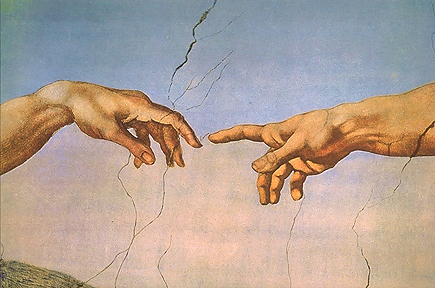
(With thanks to Dr. Seuss and Michelangelo)
And do remember...
When
you look with your eyes at all that is art,
The best began not in head,
but with wide open heart.
By
hand it was made and by hand often touched
-
A
token of passion, of history and such....
The paintings
& drawings below are from our 2011
acquisitions.
Click
on the images for more information.
|
|
|
|
|
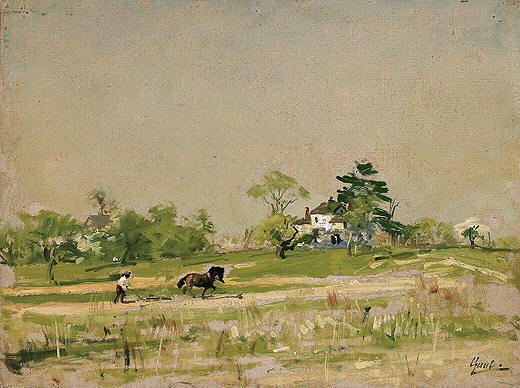
William Gilbert Gaul, (American / NJ & Tennessee)
1855-1919
"Southern Farmscape"
Oil on Canvas
Provenance : Oceanside Museum, Oceanside CA
Image Size : 12” x 16”
SOLD
|
William Gilbert Gaul,
the most important painter to work in Tennessee during the 19th century,
was a native of New Jersey. Gaul moved in 1881 to Van Buren County, Tennessee
- located in the rugged Cumberland Mountains - where he had inherited
about 5,000 acres from his uncle. Conditional to his inheritance was
that he live on the property for 5 years. Prior to that time, working
in NY, Gaul had become the highest-earning artist in America. To accept the
terms of inheritance, he gambled, leaving all he had built behind him, and
coming to rural Tennessee. He converted a barn into a studio, brought
his wife, and later built a cabin on the land.
During that period, he painted many natives of the
region, in indigenous clothing as well as Civil War uniform.
Gaul is probably most famous for his
illustrations depicting the Civil War,
and later World War I.
He was also commissioned as a special agent of the United States census of
1890, to visit the Cheyenne and Standing Rock Indian Reservations in North
Dakota. There he executed some very lyrical and haunting paintings.
Gilbert Gaul was the youngest full-time student
ever admitted to the prestigious National Academy in NYC,
and studied at Art Students League (NY) with well-known painter
John George Brown.
The
landscape depicted is probably Van Buren,
Tennessee.
The Jack Pines and type of architecture both typify the area surrounding and
east of Nashville. The condition is excellent and
provenance from The
Oceanside Museum, California.
|
|
|
|
|
|
|
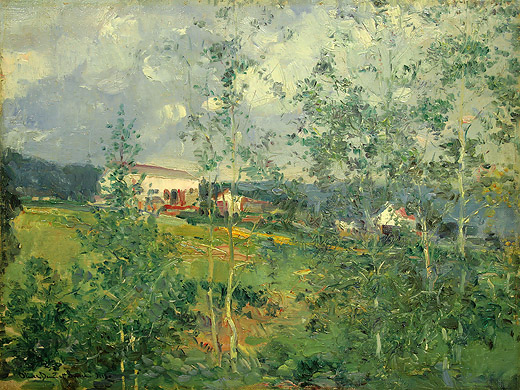
Oliver Dennett Grover, (American / Illinois / England) 1861-1927
"Hillside in Summer, 1919"
Signed and Dated
Oil on Canvas
Image Size : 12" x 16"
SOLD
|
Oliver Dennett Grover was
regarded during his
lifetime as an art authority
in Chicago, which he
believed would become "a
leader in the world of art".
The year after his death,
The Art Institute of Chicago
organized a memorial
exhibition for Grover.
In 1879, Grover enrolled in
Munich's Royal Academy,
studying with Frank
Duveneck, traveling further
to study with him in Venice
and Florence.
At the young age of 19, he
was already exhibiting at
Munich's International
Exposition.
After additional studies in
Paris with Boulanger and
Laurens, he returned to
Chicago and was a major
force there for the rest of
his life. He was awarded the
Yerkes prize in 1892 for a
large work, Thy Will Be
Done, which he again
exhibited at the World's
Columbia Exposition.
His work resides in many
museums, collections, and
public institutions,
including The High Museum,
St. Louis Museum, Cincinnati
Museum, Art Institute of
Chicago, Detroit Art
Institute, and the Union
Club of Chicago.
Hillside in Summer, 1919,
is quite French
Impressionist in its feel,
as are many of his viewed
works. The short
broken brushstrokes in this
work dance back and forth
across the canvas
foreground, the tree trunks
weaving a vertical
latticework in
lost-and-found values
against a sunlit hillside
and farmhouses, reversing
how a less creative painter
might have depicted the
scene. It is an exceptional
example of his work that we
are pleased to offer.
|
|
|
|
|
|
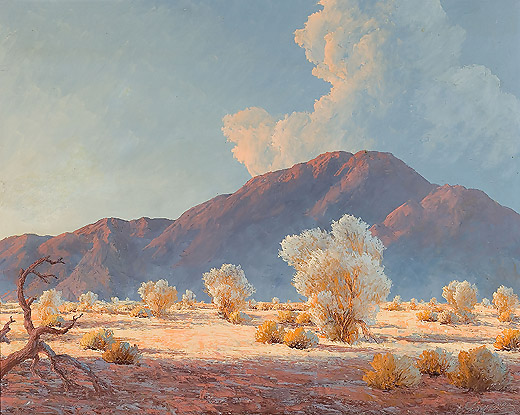
John William Hilton, (American / California) 1904-1983
"Desert Afternoon"
Oil on Panel, Original Frame
Image Size : 16" x 20"
SOLD
|
The
Sonora Desert
was the
setting for most of John
William Hilton's paintings.
The works depict the
fleeting desert light and
atmospheric conditions -
often quite delicate.
But many painters do that.
There is something more
hypnotic about Hilton's
works - just as there is in the
desert itself. His technique
employs a
combination a
beeswax mixture with the oil
paints, giving his
landscapes an encaustic
quality and a luster
that
enhances the soft
colorations. The foreground
strokes are often almost
three-dimensional, set
against a flatly painted
background, recreating the
dimension of the vast
spaces visible at once in
the desert. The colors
range from "on-fire" to a
soft evening glow. The
overall effect is one that
is hard to take your eyes
from.
Hilton led a rich,
imaginative and colorful
lifetime. Not only did
he paint with notables in
the art world (as
Maynard
Dixon,
Nicolai Fechin, Jimmy
Swinnerton, Orpha Klinker,
and Clyde Forsythe), but with
friends
Dwight Eisenhower
and
James
Cagney. He selected
the California site for a
base for
General George
Patton, with whom he
also
remained friends.
Howard Hughes
visited him
from time to time.
Each New Year's
Eve, Hilton used to burn his
"lesser" paintings in a huge
desert bonfire, leaving
behind ashes and tequila
bottles
- the ritual intended to
make him strive for
"greater" paintings. I guess
it worked, as his work hangs
in 6 museums - and while
Eisenhower was President -
hung in the Oval Office at
the White House. |
|
|
|
|
|
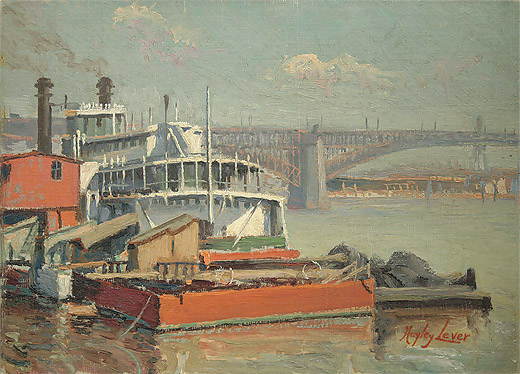
 |
|
Richard Hayley Lever, (Australian /
American), 1876-1958
"Paddle Steamer Mark Twain, Mississippi
River Eads Bridge, St. Louis"
Oil on Canvasboard
Signed Lower Right, and Inscribed
Verso "Mark Twain Ha.........."
Image Size : 10" x 14"
SOLD
|
Richard Hayley Lever remains
one of my favorite painters.
He stated during his
lifetime:
"Art is the recreation of
mood in line, form and
color. If I were
confined to my own backyard
for the rest of my life, I'd
still have more pictures in
my mind than I would have
time to paint.
Art is nothing but having a
good time."
This attitude is evident is
most of his works - his
almost child-like pleasure
in putting paint to canvas
was always apparent, whether
a misty harbor scene or the
exuberant color of nature.
This year we have three
excellent additions of
Lever's work - the first
being a very rare painting
not only for Lever, but for
American history - that of
the
St. Louis Paddle-Steamer
"Mark Twain",
and the historic
St. Louis Eads Bridge,
that when built employed
such new techniques that an
elephant
was forced to
precede humans on the first
crossing in 1874. In
1902, the Chicago Tribune
documented a rare afternoon
on this boat, when, beneath
the flags of France and
America, with the
descendants of Lafayette and
Rochambeau,
Mark Twain steered the
harbor boat up the
Mississippi for his final
ride. The
boat was subsequently named
after him:
There was cryin' and cursin',
but Mark yelled out,
Over all the infernal roar:
"I'll hold her nozzle agin
the bank
Till the last galoot's
ashore!"
Through the thick, black
smoke of the harbor boat
Mark Twain's loud drawl was
heard,
And they all had trust in
his cussedness
And knowed he would keep his
word.
But soon as they run the
gang plank out
They hurried to git ashore,
Fur they knowed Ole Mark
hadn't steered a boat
Fur forty years or more.
I
can only imagine a
meeting of the two - the painter and
the
“penner”. This
painting may be as close as
they could come. Mark
Twain died in 1910, just two
years before Hayley Lever
immigrated to America.
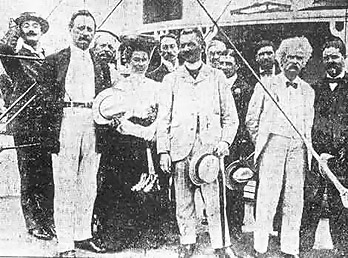
|
|
|
|
|
|
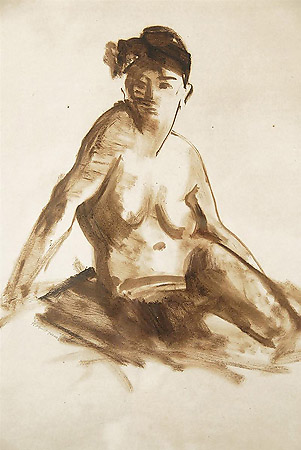
Robert (Cozad) Henri,
(New York / Pennsylvania) 1865-1929
"Seated Nude"
Sepia
Ink & Watercolor on Paper
Image Size : 17" x 11.5"
Bearing
labels verso : Chapellier Galleries, New York; Maynard Walker, New York;
Irving Brenner Fine Paintings,
Pelham, New York
SOLD
|
|
Robert Henri remains one of America’s most
important painters. He was
a founder of the New York group of painters
- “The Eight” - later known
as The Ashcan School. He was a highly influential teacher at New York’s Art Student’s League, as well as
several other schools, including the New York School of Art (formerly the Chase
School).
His merits, museums and literature are far too vast to attempt in a few
words. His collection of lectures, published as
The Art Spirit
(1923), greatly influenced the course of American art because he encouraged
many students towards independence and personal expression, urging them, in
particular, to pay close attention to their feelings and reactions to
subject matter and to translate these directly into their paintings. As a
teacher he also stressed self-reliance and self-respect.
Most know Henri for his
strong portraits, lit usually with classical three-quarter lighting, producing powerful
contrasts, enhanced through slashing directional brush strokes
and the use of strong color. The
equally powerful drawings are executed
with the same spontaneity, strength and immediacy
found in his finished paintings, including, in this instance, 3/4
directional lighting.
In addition, drawings often show the artist actively thinking on paper -
the exploration, losing and finding what is important -
with a minimum of description. It is akin to the 3-minute speech - sometimes more effective than the full-blown
depiction. We are please to present this very strong drawing in ink
and watercolor.
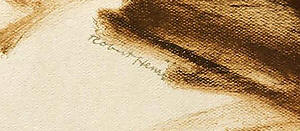
|
|
|
|
|
|
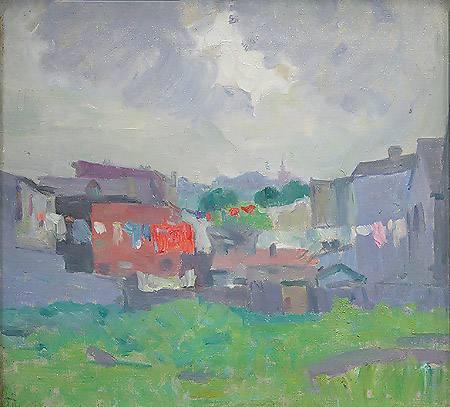
Elisha Kent Kane Wetherill, (American / NY)
1874-1929
"Back Lot with Laundry Lines"
Oil on Canvas,
Estate Stamp verso
Image Size : 13" x 14"
|
This year we added another work by
Philadelphia and New York
painter Elisha Kent Kane
Wetherill - a simple but whimsical scene of
laundry lines stretched above green
grasses that doubtless no
longer exist in this New York back lot. The
vibrancy of the clothes-pinned vermillion shirt stands out with both dimensional
brushwork and color in this luminous but quiet genre painting of a city
setting at the beginning of the 20th century.
Wetherill
studied with Thomas Anshutz at the Pennsylvania
Academy of Fine Art in the late 1890s and from 1906-09, with J.P.
Laurens at the Académie Julian in Paris, 1902, and with James Abbot
McNeill Whistler, also in Paris. He
specialized in views of New York, including figural work as well as
landscapes and seascapes. He was a member of the National Academy
of Design, Salmagundi Club, Allied Artists of America, Brooklyn Society
of Etchers, and the Philadelphia Sketch Club. In 1915, Wetherill
received a gold medal at the Panama-Pacific Exposition in San Francisco
and in 1926, won a silver medal at the Sesqui-Centennial Exposition in
Philadelphia. He also exhibited at the Art Institute of Chicago,
and at the National Academy of Design in 1925.
|
|
|
|
|
|
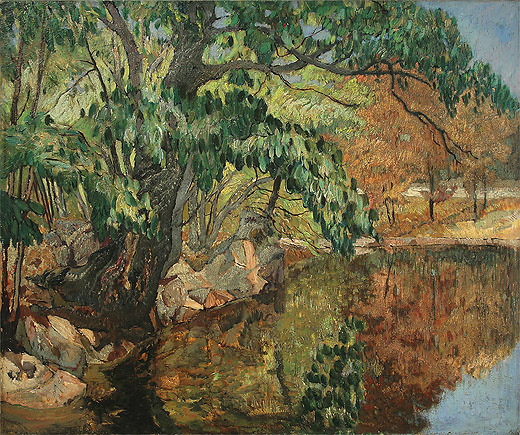
Richard Hayley Lever,
(Australian / American) 1876-1958
“Autumn” (Marblehead
Pool), c1925
Oil on Canvas
Image Size : 25” x
30”
With accompanying essay by noted early 20th
century American art curator Valerie Ann Leeds
Provenance, Kennedy Galleries NYC
SOLD
|
Also offered this year by
Australian-American painter
Richard Hayley Lever, is
a rich and lyrical landscape
entitled verso "Autumn".
When purchased, we knew only
that it had come from
Lever's estate to New York's
Kennedy Galleries, who
handled much of the Lever
estate. It went thence
to a corporate collection.
But
we did not know when it was
painted - or where.
After purchasing "Autumn",
quite by accident, I
happened upon the watercolor
below,
with the same
Kennedy Galleries label,
titled and dated
"Marblehead Pool, 1925".
The watercolor is obviously
of the same setting from a
different vantage point, and
most likely a study in
preparation for this
outstanding oil.
"Autumn", as said, is quite
lyrical for Lever's larger
works. While many of
smaller Lever's works are
free and playful, some of
the larger ones often become
somewhat more structured and
linear. In "Autumn", the
branches'
curved lines dominate the
structure,
rather than the straight
lines he often favored -
lending a quiet grace as
opposed to angularity.
With the oil paints, Lever
mixed Damar Varnish,
enabling each single
brushstroke to build a
dimensional layer of paint,
providing not only linear
motion to the stokes and
what they depicted, but also
a hint of sculpture
This same technique is used
on Lever's painting, The
Port of St. Ives,
Cornwall, chosen by Carol
Lowrey for the cover of her
monolith Hayley Lever.
She describes this technique
as
applying "his pigment in
a dense impasto to produce a
crisp, tactile surface".
With this tactile surface,
he combined a myriad of
greens - olive to cobalt and
viridian - played against
earth tones, and
complemented with triangles
of vibrant blue to the
sky - all mirrored in the
pool.
The entire composition is
unusual for Lever and
extremely successful
- so successful that Ashcan
School and Robert Henri
curator Valerie Leeds asked
if I would like for her to
write an essay on it.
Ms.
Leeds' essay is included along with
both the watercolor and the
oil "Autumn".
|
|
|
|
|
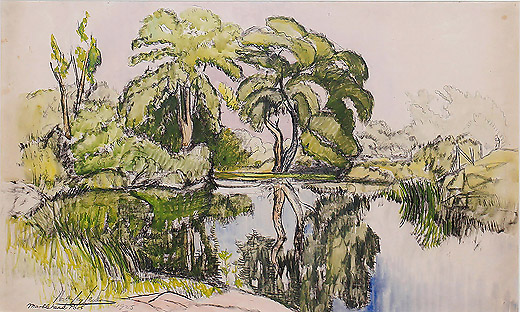
Richard Hayley Lever,
(Australian / American) 1876-1958
"Marblehead Pool, 1925"
Watercolor on Paper
Image Size : 14” x 22”
Provenance: Kennedy Galleries NYC
SOLD
|
This watercolor on paper, entitled
"Marblehead Pool, 1925", depicts the same setting as "Autumn", but from a different vantage point.
The handling of the setting is similar, with the
water reflections and sparing use of blue in the water.
If you look closely, you can see the change
of vantage point from this image, to the artist's position in "Autumn"
- across the pond, to the left of the two large trees, looking across to
the small row of sketched trees and road on the right in this
watercolor.
It is an extreme pleasure to offer
both of these paintings at the same time. Together, they show not only
the thought process of the artist, but one of the better fully developed
oil paintings available by Hayley Lever.
|
|
|
|
|
|
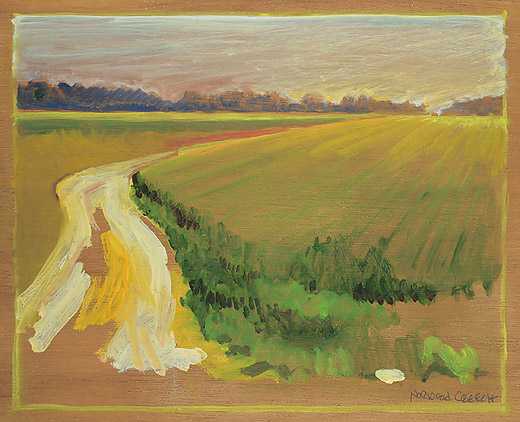
Norwood Creech,
(Arkansas / Tennessee) Contemporary
Floodway View, Oil Sketch 2011
Oil on Luan Panel,
Image Size : 11" x 14"
SOLD
|
|
Norwood Creech is the third
in a family of female
painters, all well schooled
in the classical traditions
in both painting and
drawing. Yet Norwood's
style has
emerged distinctively her
own, combining the best of
classical aspects with best
of the contemporary spirit,
energy and brevity. She has
already attained a
strong auction record and
had noteworthy honors and
exhibitions. These honors
include a
Master Program with Wayne
Thiebaud,
at Santa Fe Institute; an exhibition
for the Lincoln Center
Institute for Aesthetic
Learning;
and a
residency at Dorland
Mountain Artist Colony,
Temecula, California.
She has had numerous
exhibitions, including the
University of Memphis
Museum, Southern Tenants
Farmer's Museum, and The
Butler Center for Arkansas
Arts. She is represented in
some leading collections
throughout the United
States.
In January, Norwood has the
privilege
of curating for The Arkansas
Center for the Arts, Little
Rock, an exhibition from the
Center's collection
entitled "Horizons
Interrupted".
She has selected works in
which the horizon line is a
critical element of the
composition, as she finds
that this element, whether
high or low, provides an
important founding spatial
reference for works of all
genre.
One has only to live in
or drive through the flat
flood plains of Eastern
Arkansas to fully appreciate
the importance of her
vision.
The current landscape, with
its seemingly endless
horizon, was created by the
floods following the New
Madrid Earthquakes in
1811-12, and
again disastrously flooded
in the Spring of 2011 -
shortly before this painting
was executed.
That horizon is the
foundation of the land's
culture and even its
industry - interrupted only
by periodic tree-lines (as
above), buildings, and water
and agricultural towers.
The
exhibition runs January 13 -
March 11, 2012.
|
|
|
|
For more fine art, please see
(Fine Art Page :
https://www.mfordcreech.com/Fine_Art.html
)
For additional 2011 Fine Art
Acquisitions, click below :
https://www.mfordcreech.com/2011_New_&_Incoming_Stock_Catalog.html#Fine%20Art
Please also see :
Christmas Catalog 2011, Part I - Ceramics & Glass
Christmas Catalog 2011, Part II - Silver
Christmas Catalog 2011 - Part IV
|
|
Should you
have further
questions,
please
email, call
or come to
visit.
Millicent
Ford Creech
901-761-1163
(gallery) /
901-827-4668
(cell)
581 S.
PERKINS ROAD
/ LAURELWOOD
COLLECTION /
MEMPHIS, TN
38117
Hours :
Wed.-Sat.
11-6, or by
appointment
Complimentary
Gift
Wrapping
mfcreech@bellsouth.net
or
mfordcreech@gmail.com
www.mfordcreech.com
To receive
our periodic
email
catalogs,
please click
here.
American Express, Mastercard, Visa and Discover accepted
|
|
|
Home
Accessories
Ceramics
Early Asian Ceramics
Fine Art
Furniture
Glassware
Silver |
|
|
|
Christmas Catalog / Fine
Art
 
© Images and some text are copyrighted by this gallery.
Please reproduce with our specific written permission only.
|
|
|
|